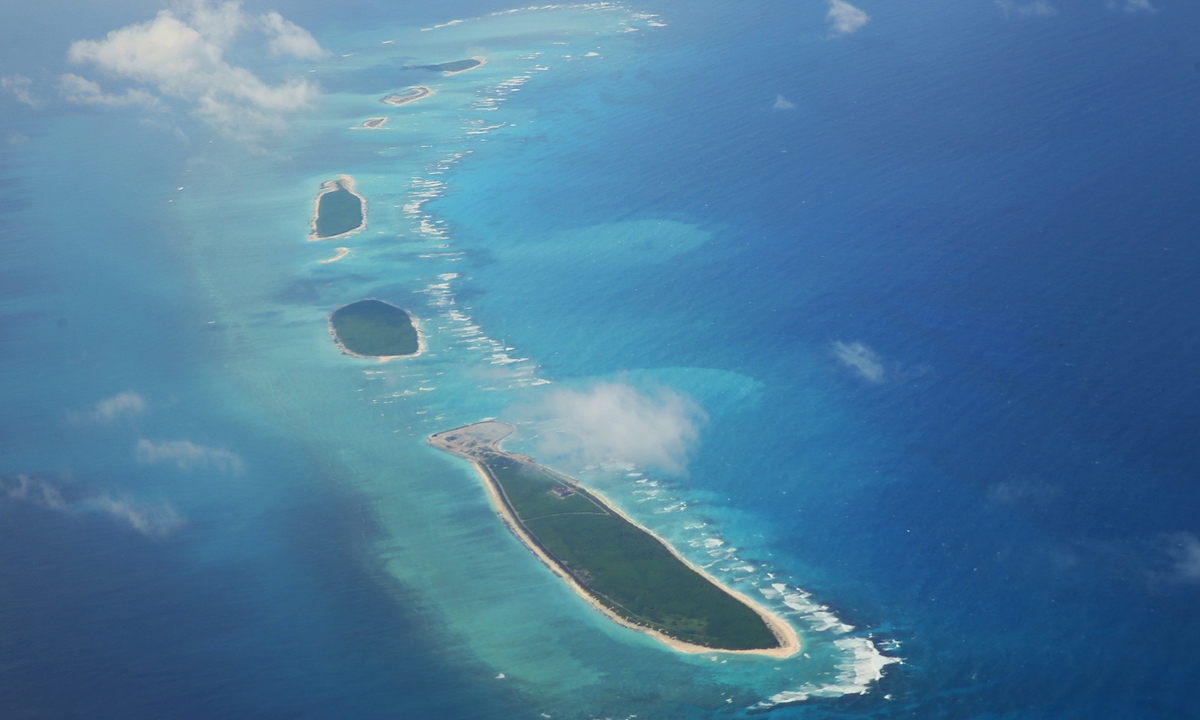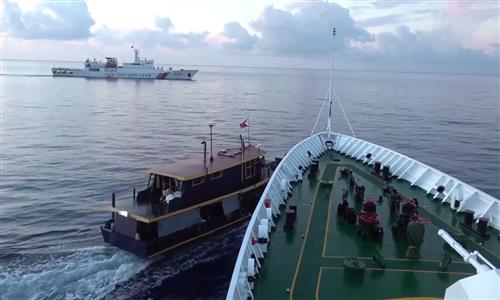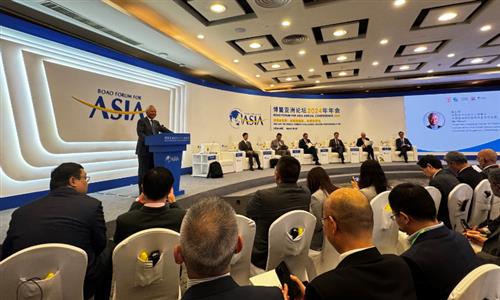
South China Sea Photo: VCG
Editor's Note:On Friday, a one-day session organized by the National Institute for South China Sea Studies (NISCSS) was dedicated to discussing the development of the South China Sea situation in Boao, South China's Hainan Province. This session was part of the South China Sea subforum at the Boao Forum for Asia Annual Conference 2024. To gain insight into how scholars from regional countries view the development of the South China Sea issue, the Global Times selected key opinions from several participants based on their addresses and interviews conducted during the subforum.
Wang Sheng, president of the NISCSS
The overall situation in the South China Sea is still manageable; however, the current Philippine government's limited political desire to meet China halfway over the South China Sea disputes pose a big challenge to regional peace and stability.
Another threat to the easing of tension is the interference of extra-regional countries, including the US and Japan, in this issue. In particular, the degree of their involvement has become increasingly deeper and militarized. The recent increase in their involvement in the South China Sea has heightened the shadow of geopolitical rivalry in the region, disrupting and hindering the agenda of regional cooperation in the South China Sea.
The Philippines and the US will hold annual military exercises known as Balikatan or "shoulder-to-shoulder," about 22 kilometers off the west coast of Palawan facing the South China Sea from April 22 to May 8. The Balikatan drills have been ongoing for almost 40 years, but this year's exercises are anticipated to be the largest ever, with the participation of extra-regional countries, such as Japan and Australia. Through such "shoulder-to-shoulder" exercises, the US, Japan and the Philippines continue to escalate the situation in the South China Sea and attempt to disrupt the rhythm of China's efforts to defend its rights.
To maintain communication and coordination with the countries concerned in the South China Sea and resolve regional disputes in a peaceful, fair and cooperative manner, multiple channels such as Track I and Track II dialogues should be adopted. Regional countries can engage in more concrete forms of cooperation, especially in areas of low sensitivity. For example, there is still significant room for cooperation in the digital economy, green economy and ocean economy, which provides a good foundation for building a maritime community with a shared future in the South China Sea.
Dino Patti Djalal, former deputy foreign minister of Indonesia and chairman of the Foreign Policy Community of Indonesia
Out of the five major hot-spot tensions in the world, the South China Sea is a rare place where all the claimants are talking routinely in an official and structured format. This is because the talks linked to a clear pathway [for South China Sea peace and stability], which is called the Code of Conduct (COC), are going way too slow, but at the very least, the guns are silent and have been silent for quite some time.
Exercising self-restraint is critically important. All claimants need to avoid actions that will provoke responses from others. This is important because once an incident starts between two or more claimants, there's really no mechanism to stop it. So self-restraint is a form of preventive diplomacy, and it is essential for all claimants to practice it.
We also need greater efforts focused on confidence-building. The South China Sea situation is evolving in a larger context of intensifying rivalries, low trust, rising insecurity and tension. And there is the possibility that brinkmanship will come forward. Unfortunately, the South China Sea at the moment is suffering from a noticeable lack of confidence-building measures, which explains the low trust that exists now among some of the claimants.
The ability of China and ASEAN to manage the South China Sea disputes peacefully will serve as a powerful example to a troubled world, demonstrating that the relationship between the two sides is also a robust problem-solving partnership and that Asians have the craft, skill and political will to transform conflict into cooperation.
Nguyen Hung Son, vice president of the Diplomatic Academy of Vietnam
The current world order is facing critical challenges, but the new order is yet to take shape. Uncertainties in this situation may prevail, leading to confusion, wrong presumptions, miscommunications and even miscalculations. The outcome of such a scenario would be catastrophic, resulting in a lose-lose scenario where everyone competes for a bigger piece of the pie while the whole cake becomes smaller.
In the context of the South China Sea, the risk of confusion and miscalculation is very high. There's a concern that if the risk is not well-managed, the South China Sea could become yet another hotspot that could destabilize the whole region. I think the current standoff in the South China Sea is very risky, and we must handle it with caution. It is easy to escalate but difficult to de-escalate, as it can quickly become militarized and internationalized.
So it is important that we handle this hotspot issue with extreme care. To do so, it's crucial that we must work together to cooperate, reduce confusion and minimize miscalculation. And we can do so by strengthening the strategic communication and dialogue. We have to communicate our intention very clearly, and we must not send the wrong signal to other sides. We also need to build a code of conduct that is going to minimize misunderstanding and miscalculation.
In conclusion, [we should make sure that] the South China Sea - the cake - is a peaceful and stable environment so that it can function as a hub of connectivity for the world's most important economic region. If countries compete to grab a bigger piece of the pie, they risk stamping on the cake and end up ruining their own very piece of the cake.
Shafiah Muhibat, deputy executive director for research, Centre for Strategic and International Studies in Indonesia
Only three months into 2024, there are already some significant developments in the South China Sea. There are at least four factors that could ignite conflicts in the South China Sea. One is the factor of unintentional incidents. The second factor is deliberate provocation or gestures by one entity to assess the determination of another. The third factor is the inability to reconcile disputes through lawful or diplomatic avenues, leading to impasses in dialogue and consultation. The fourth factor is external factors: involvement of outside powers might create unintended results as well.
It is becoming more apparent that ASEAN's efforts to reach an agreement with China on the COC will take time, with difficult issues yet to be resolved despite recent efforts to accelerate the process.
So these are the challenges going forward this year. It seems that we are looking at more challenges than opportunities. However, increased tension, more incidents, or anything that may lead to an open conflict are definitely not in any party's interests. We need to underline that no country wants to see an all-out conflict in the South China Sea. And I think that is the biggest opportunity we have.
Yet, this should not be taken for granted. With increased confrontations at sea, if we are still lagging behind in some existing processes, it leaves us with no effective mechanisms to prevent and mitigate the risk of open conflict. Therefore, continued engagement and fostering regional cooperation are essential. More and more challenges are appearing, but we are trying to catch up with our slow process in cooperation, so let's not fall behind in the race.


